Learning Japanese can be really fun and interesting at times! I struggled a lot when I first came to Japan without knowing even the basic words like, goodbye or thank you in Japanese.
In most cases, people don’t speak in English and even if you look like a foreign traveler, some would still talk to you in Japanese.
Well, much lesson learned from that experience so I got myself interested in studying Nihongo and here are some expressions that Japanese people use when saying goodbye.
If you want to sound like a native Japanese, read on and be confident to use it once you get the chance!
Contents
Sayounara
| Hiragana | さようなら |
|---|---|
| Pronunciation | [sah-yoo-na-rah] |
Sayounara is a formal way of saying goodbye in Japanese. However, this expression is seldom used in a daily conversation.
Given scenario is that in a classroom, the teacher would say sayounara to his/her students and the students would respond with the same expression.
Mata ne!
| Hiragana | またね |
|---|---|
| Pronunciation | [mah-tah-neh] |
Mata ne is the most common expression when you are parting ways with friends or loved ones but it does not mean goodbye but rather translates to “see you” in English.
It is indeed a more casual way of telling someone that you are hoping to see him/her again.
Jaa, mata (ne)
| Hiragana | じゃあ、また(ね) |
|---|---|
| Pronunciation | [jaah-mah-tah] |
Jaa, mata (ne), is another casual way of expressing your hope that you will see the other person again some other time. Japanese men often used “Jaa, mata” and women often add “ne” on the last part.
Jaa ne..
| Hiragana | じゃあ、(ね) |
|---|---|
| Pronunciation | [jaah-neh] |
Jaa ne also has the same meaning as the expressions mentioned above. It does not really translate to goodbye but this is a good expression to use when parting ways with someone close to you.
Bye-bye!
| Katakana | バイバイ |
|---|---|
| Pronunciation | [bai-bai] |
Here’s another expression used for goodbye. This is called the Japanese-English word “Bye-bye”. As clear as it sounds, this can be used when talking to friends, family, and loved ones.
Children also use this word when they want to let their friends know that they are already leaving.
Mata ashita
| Hiragana | またあした |
|---|---|
| Pronunciation | [mah-tah-ash-tah] |
Mata ashita simply translates to “see you tomorrow” in English. Use this expression when you are certain to meet someone tomorrow.
Mata atode
| Hiragana | またあとで |
|---|---|
| Pronunciation | [mah-tah-a-toh-deh] |
Mata atode means “see you later” and this can be used when talking to your acquaintances or friends that you’re gonna meet up later.
Mata kondo
| Hiragana | またこんど |
|---|---|
| Pronunciation | [mah-tah-koh-n-doh] |
Mata kondo is like “saying see you soon” in English. It is safe to use this phrase when talking to friends, classmates, or family.
Genki de ne!
| Hiragana | げんきでね |
|---|---|
| Pronunciation | [gen-kee-deh-neh] |
“Genki de ne” is also a common expression used by the native Japanese people when bidding farewell to their friends, or acquaintances. It simply means “all the best” in English.
Ittekimasu!
| Hiragana | いってきます |
|---|---|
| Pronunciation | [ee-teh-kee-mahs] |
Ittekimasu is mostly used only for family members when someone’s about to go out. It translates to “I’m leaving home” in the English language. Yes, you read it right! It functions as a polite way of informing a family member that you are about to go.
In some cases, this can also be used at work so you can say this expression to your colleague when you are leaving the office for a short while.




